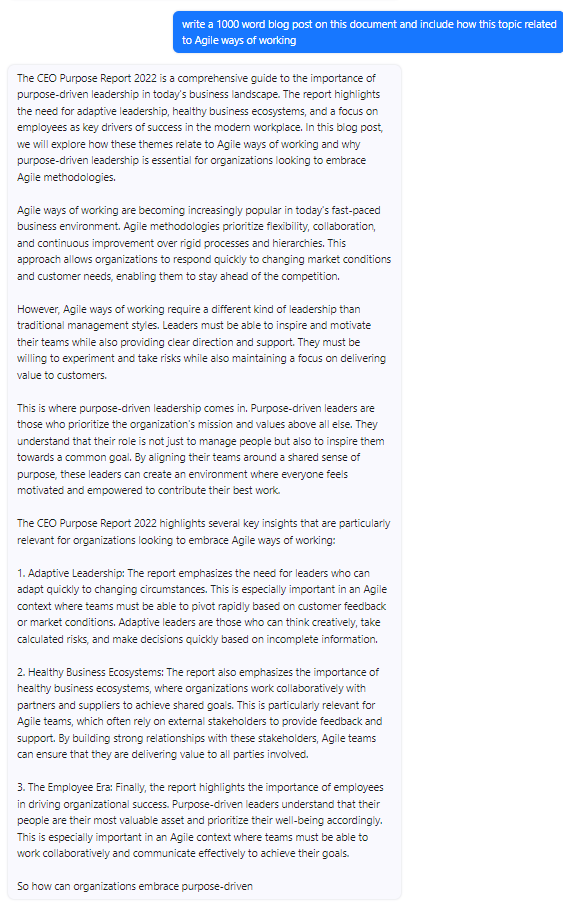
Why Purpose-Driven Organisations Outperform Their Peers: Insights From 1000 CEOs
In this post I’ll use some recent research to encourage leaders to be more purpose driven as they sponsor change programs to design and implement new ways to work.



Why purpose matters now more than ever
In this post I want to discuss a very human aspect of my consulting work, organisational purpose. I am not talking about a branding exercise or nicely produced videos that warm the heart, but something more tangible, a real thing that has utility. So, what is the role of purpose when designing and enabling the adoption of a new delivery or operating model. The short answer is that a purpose helps leaders to engage, motivate and inspire their workforce during a change program. With a well-defined, strong purpose, leaders will be better equipped to answer questions from the workforce such as:
WHY should I go the extra mile for this organisation?
Do I care enough to improve how I/we work?
WHY should I listen to what leaders have to say?
WHY am I here and what’s in it for me?
WHY bother/who cares/WHY should I care?
What’s important for us to do next?
Where are we going?
Is this the right place for me at the moment?
Having a clear, documented purpose that is actually used on a day-to-day basis as staff plan and deliver outcomes or seek to adopt new ways to work, will save leaders a lot of time and effort due to its ability to cut through and answer these types of questions. In this post I’ll use some recent research to help you see the value in being more purpose driven in how you redesign or implement new ways to work. Hopefully once you've finished reading you will completely rethink what it means to enable change across an organisation; but don't take my word for it, here's what 1000 CEOs said.
What 1000 CEOs have to say about the value of PURPOSE?
For the last four years a survey has been conducted asking 1000 CEOs from across the globe about the importance of purpose (Brandpie CEO Purpose Report 2022); it is interesting reading for leaders, executives and sponsors considering changing the way their organisation works. Let me save you some time by summarising the 28 pages into the three top themes; I'll then relate each theme to how it could be used during a change or transformation program.
1. Purpose Matters
Successful CEOs perceive purpose to be important for driving business growth.
Looking back on the last five years, the research indicated that many CEOs (42%) say that they have created most value for their organizations by using technology to improve offerings and processes. But purpose (58%) narrowly edges out good products and services (54%) and cutting-edge technology (54%) when it comes to creating long-term value.
How to use this to improve your way of working
To quote Simon Sinek “people don’t buy what you do, they buy why you do it.”
So if your organisation is “selling” (to internal staff and stakeholders) the idea of changing the way it works, we’d recommend you spend less time on what the new way of working is and more time on why the change is necessary to enable the organisation to achieve its purpose.
Too often an Agile, agility or ways of working change programs get so hung up on the new processes, roles and responsibilities that the underpinning reason for change is de-emphasised. People are busy publishing the “playbook” of practices when the workforce is still wondering “why are we doing this and why should I bother supporting the change?”
If staff are engaged in the organisation’s purpose, then they will support any change that improves the chances of this purpose being fulfilled. Start with the purpose; then move onto to how.
2. Business Ecosystems
CEOs are utilizing purpose to manage their ever-growing stakeholder network.
Every business is part of a rich and interconnected ecosystem, yet today many act as if they were islands. In doing so, they often neglect the interdependencies of their network and their potential to influence change. The report goes on to say…
our ability to collectively innovate, … and move from models of competitive advantage to radical collaboration. We need to nurture healthy business ecosystems that are resilient and adaptive in the face of increasing uncertainty.
How to use this to improve your way of working
If your organisation is changing the way it works, then how it collaborates with vendors, suppliers, partners and other players in its network to deliver value and fulfil its purpose needs to be designed in from the start. For example, if you use an external vendor to manage a core platform or process, then including them in the design of your new way of working will be critical.
As an independent consultancy, Source Agility chooses who we want in our ecosystem; when considering working with an organisation we start with their why, the culture, then move on to what they do. An organisation needs to constantly consider how its purpose impacts reputation and standing in the market; neglecting this could negatively impact your ability to attract the best employees, vendors and partners.
3. The Employee Era
CEOs and Chief People Officers need to overcome the great employee challenge of our age.
Today’s workforce is contemplating essential questions about their personal and professional lives, as well as the intersection between the two. The report goes on to say…
The traditional model of employees complying to an organization’s purpose at the risk of their own has been upended. This “new normal” in the job market – one that prioritizes employees’ personal preferences and priorities – also means that purpose matters more so than ever, as organizations need to attract the best talent in order to maintain their competitive advantage.
How to use this to improve your way of working
If your organisation is changing the way it works, then maintaining employee engagement throughout the transformation journey is going to be crucial if a successful transition with high retention of talent is to be achieved. The change needs to not only make sense (win over their minds) but align with their personal values/purpose (win over their hearts).
In the employee era, an organisation needs to be more aware of just how much “inconvenience” staff will bear as part of doing their job as a change program is rolled out. By focussing communications on the why behind the change and its connection to purpose, employees will be connected more deeply to what the organisation is trying to achieve through changing the way of working.
Final words and a ChatGPT experiment
It is tempting to see the introduction of change as a plan to be implemented through a series of scheduled tasks. People do this because they want change to be simple (not complex). People crave certainty; if we introduce change ‘X’ the behavioural outcome in the workforce will be ‘Y’. Unfortunately changing how humans behave does not work like that; we do not know what will happen when we change ‘X’.
People's behaviour is driven by how they feel, not by what they know. Winning the hearts as well as the minds of a workforce is critical if a new way to work is to ‘stick’ and embed into the organisational culture.
Starting with WHY and a focus on purpose is, in my opinion, the best mitigation to the risk of a change program failing.
p.s. I ran a ChatGPT experiment; here's how ChatGPT would have written this blog post:



